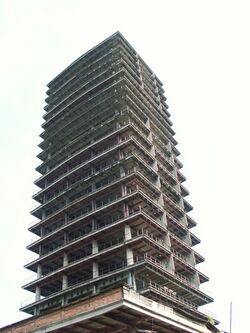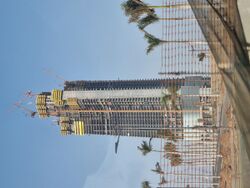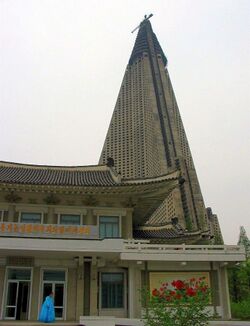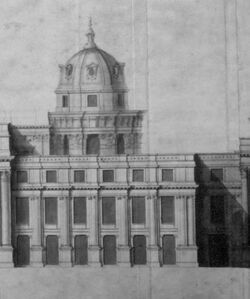Engineering:Unfinished building

An unfinished building is a building (or other architectural structure, as a bridge, a road or a tower) where construction work was abandoned or on-hold at some stage or only exists as a design. It may also refer to buildings that are currently being built, particularly those that have been delayed or at which construction work progresses extremely slowly.
Many construction or engineering projects have remained unfinished at various stages of development. The work may be finished as a blueprint or whiteprint and never be realised, or be abandoned during construction.
One of the best-known perennially incomplete buildings is Antoni Gaudí's basilica Sagrada Família in Barcelona.[1] It has been under construction since 1882 and planned to be complete by 2026, Gaudí's death centenary.[2]
Partially constructed buildings



There are numerous unfinished buildings that remain partially constructed in countries around the world, some of which can be used in their incomplete state but with others remaining as a mere shell. Some projects are intentionally left with an unfinished appearance, particularly the follies of the late 16th to 18th century.
Some buildings are in a cycle of near-perpetual construction, with work lasting for decades or even centuries. Antoni Gaudí's Sagrada Família in Barcelona, Spain, has been under construction for around 140 years, having started in the 1880s. Work was delayed by the Spanish Civil War, during which the original models and parts of the building itself were destroyed. Today, even with portions of the basilica incomplete, it is still the most popular tourist destination in Barcelona with 1.5 million visitors every year. Gaudí spent 40 years of his life overseeing the project and is buried in the crypt.[3] Germany's Cologne Cathedral took even longer to complete; construction started in 1248 and finished in 1880, a total of 632 years.[4]
Buildings (and other architectural structures) never completed
Buildings that were never completed and remain in that state include:
- Duomo di Siena (Siena Cathedral), Italy
- Abbey of the Santissima Trinità, Venosa, Italy
- San Petronio Basilica, Bologna, Italy
- Goodwood House, West Sussex, England , UK
- Klosterneuburg Monastery, Austria
- Herrenchiemsee, Bavaria, Germany
- Prora, island of Rügen, Germany
- Goldin Finance 117, Xiqing District, Tianjin, China
- Woodchester Mansion, Stroud, Gloucester, England , UK
- Parliament House, Wellington, New Zealand
- Bishop Castle, San Isabel National Forest, Colorado, US
- Boldt Castle, Thousand Islands, New York, US
- National Monument, Edinburgh, Scotland, UK
- Ajuda National Palace, Lisbon, Portugal
- Cuenca Cathedral, Cuenca, Spain
- Jeddah Tower, Jeddah, Saudi Arabia
- Al-Rahman Mosque, Baghdad, Iraq
- Plaza Rakyat, Kuala Lumpur, Malaysia
- Ilot Voyageur, Montreal , Quebec, Canada
- Cathedral of St. Alban the Martyr, Toronto, Ontario, Canada
- Centro Financiero Confinanzas, Caracas, Venezuela
- Aspotogan Sea Spa, Nova Scotia, Canada (demolished)
- Chicago Spire, Chicago , Illinois, US
- Monumento a la Revolución, Mexico City, Mexico
- Beaumaris Castle, Anglesey, Wales, UK
- 2 World Trade Center, New York City , US
- Trump International Hotel and Tower, Baku, Azerbaijan
- Ryugyong Hotel, Pyongyang, North Korea
In other cases, construction works proceeds extremely slowly, so one can also say form incomplete structures. Examples are:
- Cathedral of St. John the Divine, New York City , New York, US
- Sagrada Família, Barcelona, Spain
- Kaliakra transmitter, Cape Kaliakra, Bulgaria
- Westminster Cathedral, London, UK
- Mosul Grand Mosque, Mosul, Iraq
Other unfinished structures
There are also roads, railway lines and channels which remained unfinished.
Roads
- MP-203, Madrid, Spain
- Interstate 710, Los Angeles County, California
- Route 11 Expressway, New London County, Connecticut
- LaSalle Expressway, Niagara County, New York
- South Mall Arterial/Dunn Memorial Bridge, Albany and Rensselaer, New York
- Seaford–Oyster Bay Expressway, Nassau County, New York
- Korean War Veterans Parkway (Richmond Parkway), Staten Island, New York
- Willowbrook Expressway/Parkway, Staten Island, New York
- Foothills Parkway, Tennessee
- Amstutz Expressway, Waukegan, Illinois
- Olimpijka in Poland
- M8 Bridge to Nowhere, Glasgow, Scotland
- The Foreshore Freeway Bridge in Cape Town, South Africa
- B 464 near Sindelfingen, Germany
- Strecke 46
- Strecke 77
- Strecke 85
- Interstate I-170 Baltimore, MD
- New Central Cross-Island Highway, Taiwan (including Provincial Highway 14, 18, 21)
Railway infrastructure
- Cincinnati Subway
- Mosel Railway (German: Moselbahn)
- Ahrtal Railway (German: Ahrtalbahn)
- Old Railway at Willebadessen
- Strategic Railway Embankment (German: Strategischer Bahndamm)
Arenas
- Deutsches Stadion
- Taipei Dome
- Nou Mestalla
- Lithuania National Stadium
Ferris wheels
- New York Wheel, New York City, New York, US
- Skyvue, Las Vegas, Nevada, US
- Turn of Fortune, Changzhou, China
Industrial plants
- Kramatorsk Metallurgical Plant [1]
- GRES-2 Power Station, Ekibastus
Nuclear power plants
- Crimean Atomic Energy Station, Shcholkine, Crimea
- Fast Breeder nuclear reactor SNR-300, Kalkar, Germany
- Lemoniz Nuclear Power Plant, Lemoniz, Spain
- Marble Hill Nuclear Power Plant, New Washington, IN, United States
- Satsop Nuclear Power Plant, Satsop, Washington, United States
- Stendal Nuclear Power Plant, Arneburg, Germany
- Unit 5, 6, 7, 8 of Chernobyl Nuclear Power Station
- Valdecaballeros Nuclear Power Plant, Valdecaballeros, Spain
- Lungmen Nuclear Power Plant, Taiwan
- Juragua Nuclear Power Plant, Cuba
- Żarnowiec Nuclear Power Plant, Poland
Electric power transmission systems
- Wolmirstedt HVDC-back-to-back plant
- Elbe Project
- HVDC Ekibastuz–Centre
Towers
- Watkins' Tower, London, UK
- Yekaterinburg TV Tower, Yekaterinburg, Russia (demolished)
- Berlin-Müggelberge TV Tower, Berlin, Germany
- Dubai Creek Tower, Dubai, United Arab Emirates
- Belgorod TV Tower, Belgorod, Russia
- Deutschlandsender Herzberg/Elster, Germany
- Wardenclyffe Tower, Shoreham, New York, USA
- Hakell Creative Educational Media, Haskell, Oklahoma, USA [2] at 35°53'0"N 95°46'15"W
- Galich TV Mast
- Sathorn Unique Tower
Visions and plans

Many projects do not get to the construction phase, halted during or after planning. Ludwig II of Bavaria commissioned several designs for Castle Falkenstein, with the fourth plan being vastly different from that of the first. The first two designs were turned down, one because of costs and one because the design displeased Ludwig, and the third designer withdrew from the project. The fourth and final plan was completed and some infrastructure was prepared for the site but Ludwig died before construction work began.[5] The Palace of Whitehall, at the time the largest palace in Europe, was mostly destroyed by a fire in 1698. Sir Christopher Wren, most famous for his role in rebuilding several churches after the Great Fire of London in 1666, sketched a proposed replacement for part of the palace but financial constraints prevented construction.
Even without being constructed, many architectural designs and ideas have had a lasting influence. The Russian constructivism movement started in 1914 and was taught in the Bauhaus and other architecture schools, leading to numerous architects integrating it into their style.
Further examples
Construction never started
- Cenotaph for Sir Isaac Newton
- The Illinois
- Millennium Tower
- Palace of the Soviets
- Point Park Civic Center
- Project of Filippo Juvarra for the Royal Palace of Madrid
- Pyramid City
- Sky City 1000
- Tatlin's Tower
- Ville Contemporaine
- Volkshalle
- Centennial Tower, Manila[6] or Pasig[7] Philippines
- X-Seed 4000
Use of computer technology
Computer technology has allowed for 3D representations of projects to be shown before they are built. In some cases the construction is never started and the computer model is the nearest that anyone will ever get to seeing the finished piece. For example, in 1999 Kent Larson's exhibition "Unbuilt Ruins: Digital Interpretations of Eight Projects by Louis I. Kahn" showed computer images of designs completed by noted architect Louis Kahn but never built.[8] Computer simulations can also be used to create prototypes of projects and test them before they are actually built; this has allowed the design process to be more successful and efficient.
See also
- Unfinished creative work
- List of visionary tall buildings and structures
- Off-plan property
References
- ↑ "North Korea's 'Hotel of Doom' to finally open: top 5 incomplete buildings", telegraph.ko.uk, 10 October 2011 (retrieved 2 October 2019)
- ↑ "Video: See How La Sagrada Família Will Progress in 2015", metropolismag.com, 25 September 2014 (retrieved 2 October 2019)
- ↑ Barcelona Information. "Barcelona Sagrada Familia ". Accessed 24 August 2006.
- ↑ UNESCO World Heritage. "Cologne Cathedral". Accessed 24 August 2006.
- ↑ Yan, Mark. King Ludwig II of Bavaria – his Life and Art. "Falkenstein". Accessed 21 August 2006.
- ↑ "Manila Standard - Google News Archive Search". https://news.google.com/newspapers?nid=1370&dat=19960107&id=Af4tAAAAIBAJ&sjid=YwsEAAAAIBAJ&pg=4040,923978.
- ↑ "Manila Standard - Google News Archive Search". https://news.google.com/newspapers?nid=1370&dat=19950930&id=kqclAAAAIBAJ&sjid=LgsEAAAAIBAJ&pg=6836,4322296.
- ↑ Eiteljorg II, Harrison. 1999. CSA Newsletter, "Seeing Buildings that Were Never Built". Accessed 21 August 2006.
External links
- Rick Edmondson's Unfinished Buildings
- Unbuilt British motorways at Pathetic Motorways
 |
